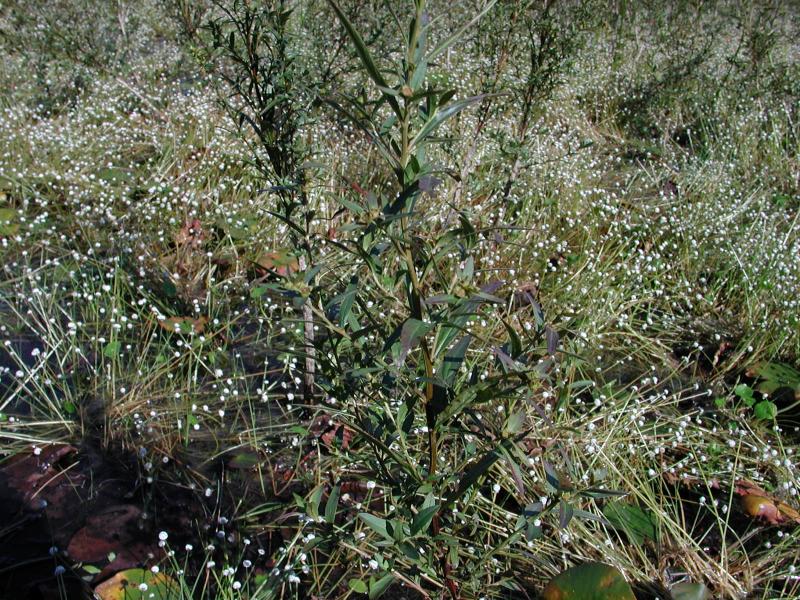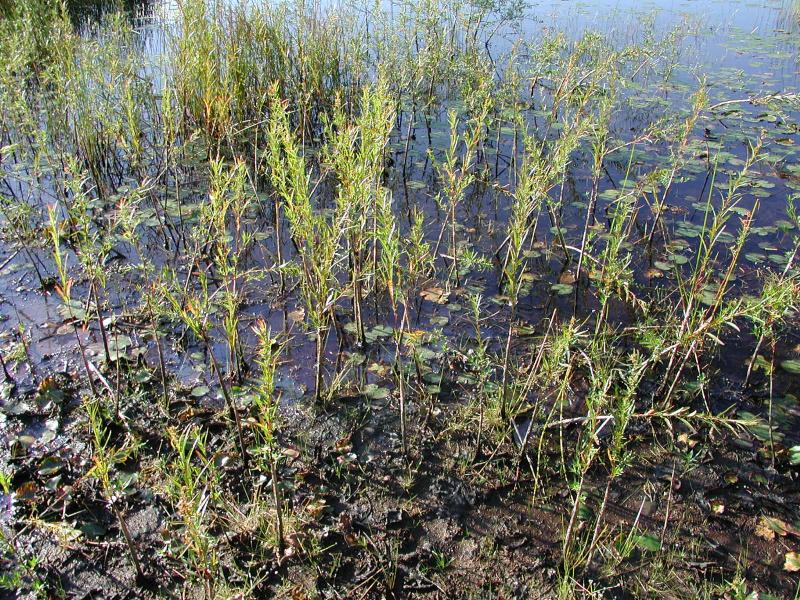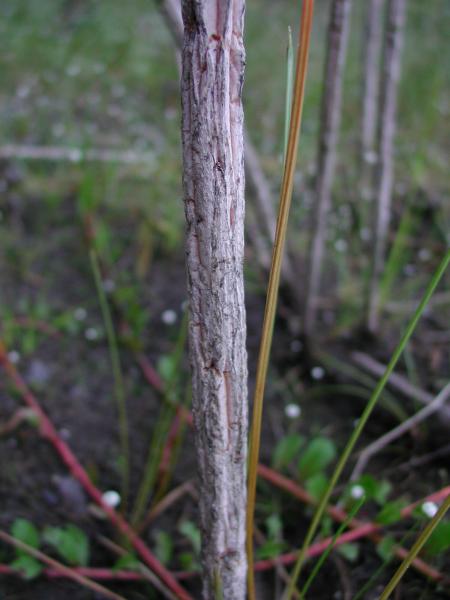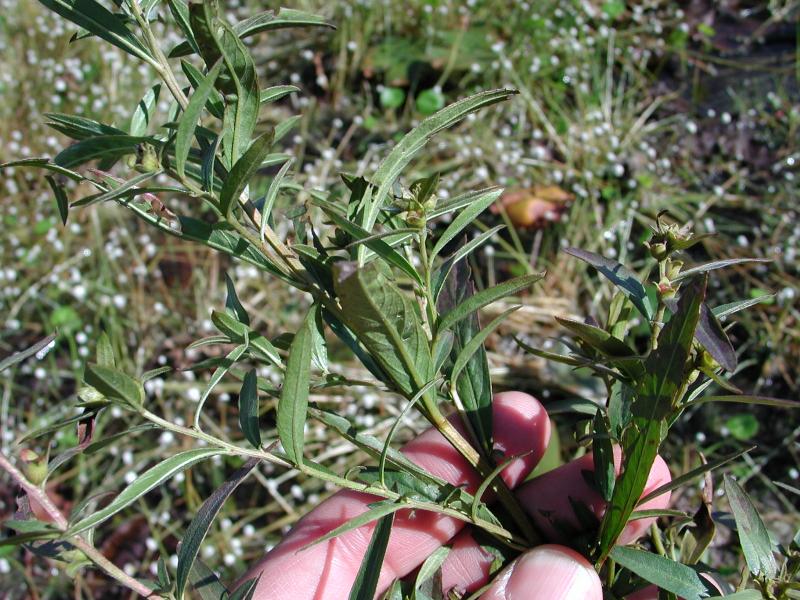Globe-fruited Seed-Box
Ludwigia sphaerocarpa Ell.
- Class
- Dicotyledoneae (Dicots)
- Family
- Onagraceae (Evening-Primrose Family)
- State Protection
- Threatened
Listed as Threatened by New York State: likely to become Endangered in the foreseeable future. For animals, taking, importation, transportation, or possession is prohibited, except under license or permit. For plants, removal or damage without the consent of the landowner is prohibited.
- Federal Protection
- Not Listed
- State Conservation Status Rank
- S2
Imperiled in New York - Very vulnerable to disappearing from New York due to rarity or other factors; typically 6 to 20 populations or locations in New York, very few individuals, very restricted range, few remaining acres (or miles of stream), and/or steep declines.
- Global Conservation Status Rank
- G5
Secure globally - Common in the world; widespread and abundant (but may be rare in some parts of its range).
Summary
Did you know?
Although this species grows almost exclusively near the coast there are a few populations known from close to 600 miles inland (Peng 1989). The specific epithet sphaerocarpa means spherical fruited (Fernald 1970) and indicates the shape of the fruits of this species.
State Ranking Justification
There are 17 known extant populations but many of these sites are very close together. There are also about 8 populations which have not been seen in over 70 years and are considered historical. This species is near the northern edge of its range in southeastern New York and the habitat that this species prefers in New York is limited.
Short-term Trends
Development has encroached upon some of the very limited habitat for this species in New York but most of the habitat at the known extant populations appears to be in good shape. At a few populations the habitat is somewhat degraded. Otherwise, there is no clear data indicating what the short term trends are for this species.
Long-term Trends
There are around 8 populations which have not been seen in over 70 years. Many of these populations occur within the greater New York City metropolitan area and may have become extirpated as a result of urbanization. It is possible that some of these populations are still extant but even if they are, it is likely they occur in degraded habitat. Although long term trends are not decisive they appear to indicate that this species has declined within the past 150 or so years.
Conservation and Management
Threats
Habitat conversion or destruction as a result of urbanization or development has probably led to the extirpation of numerous historical populations. Habitat conversion or destruction as a result of development and/or off road vehicles is a potential threat at some extant populations.
Conservation Strategies and Management Practices
Populations of this species and their associated habitats should be protected from disturbances by off road vehicles and development.
Research Needs
Historical populations should be surveyed to determine if they are still extant. Extant populations should be monitored periodically.
Habitat
Habitat
In New York, this species primarily occurs just in or on the edges of shallow coastal plain ponds set in pine barrens. These ponds vary greatly in water levels from year to year. Plants occur emergent from just within the ponds or on the exposed pond shores. They also occur in herbaceous openings in shrub swamps and along channels or outlets/inlets of wetlands in pine barrens. One population from the lower Hudson Valley occurs on floating vegetation mats and in shallow water along the shore of a pond (New York Natural Heritage Program 2007). Swamps and wet soil (Gleason and Cronquist 1991). Plants of Ludwigia sphaerocarpa grow in drainage ditches, on stream or pond shores, and in river marshes, swales, swamp forests, edges of limestone sinks, peaty bogs in pastures, and interdunal marshes (Peng 1989). Sandy and peaty pond-margins and swamps (Fernald 1970).
Associated Ecological Communities
- Coastal plain pond
(guide)
The aquatic community of the permanently flooded portion of a coastal plain pond with seasonally, and annually fluctuating water levels. These are shallow, groundwater-fed ponds that occur in kettle-holes or shallow depressions in the outwash plains south of the terminal moraines of Long Island, and New England. A series of coastal plain ponds are often hydrologically connected, either by groundwater, or sometimes by surface flow in a small coastal plain stream.
- Coastal plain pond shore
(guide)
The gently sloping shore of a coastal plain pond with seasonally and annually fluctuating water levels. Plants growing on the pond shore vary with water levels. In dry years when water levels are low there is often a dense growth of annual sedges, grasses, and herbs. Submerged and floating-leaved aquatic plants, such as fragrant waterlily and pondweeds, may become "stranded" on the exposed shore. In wet years when the water level is high only a few emergents and floating-leaved aquatics may be noticeable. T
- Pine barrens shrub swamp
(guide)
A shrub-dominated wetland that occurs in shallow depressions in the coastal plain, often as the transition zone between a coastal plain pond shore and either pitch pine-scrub oak barrens or pitch pine-oak forest.
Associated Species
- Carex striata (Walter's sedge)
- Carex stricta (tussock sedge)
- Decodon verticillatus (water-willow)
- Eleocharis robbinsii (Robbins's spike-rush)
- Eriocaulon aquaticum (northern pipewort, northern hat-pins)
- Juncus canadensis (Canada rush)
- Juncus militaris (bayonet rush)
- Lobelia nuttallii (Nuttall's lobelia)
- Osmunda cinnamomea
- Pontederia cordata (pickerelweed)
- Rhynchospora macrostachya (tall horned beak sedge)
- Xyris smalliana (Small's yellow-eyed-grass, large yellow-eyed-grass)
Range
New York State Distribution
This species occurs predominately in the eastern half of Suffolk County, Long Island. There are also a few other scattered populations currently or historically known from western Long Island to Staten Island north to the lower Hudson Valley in Ulster County (New York Natural Heritage Program 2007). There is also a specimen reported in Peng (1989) from Yates county in western New York. This is a Sartwell specimen deposited at US. Sartwell that came from Yates County and many of his specimens, although labeled Yates County, are from other localities (New York Natural Heritage Program 2007). There are a few disjunct populations south of Lake Michigan (Peng 1989) and it is possible that this species also occurs disjunct in western New York (at least historically). Since Yates County is a very unlikely location for this species and because Sartwell notoriously labeled his specimens with his place of residence it is likely the Yates County specimen came from a different locality.
Global Distribution
This species occurs in or near the Atlantic and Gulf coastal plains from eastern Massachusetts south to Florida and west to eastern Texas. It is also disjunct in southcentral Tennessee, southwestern Indiana, and along Lake Michigan in northeastern Illinois and northwestern Indiana (Peng 1989). The reported disjunct occurrence in western New York (Peng 1989) is believed to be based on a specimen from another locale (New York Natural Heritage Program 2007).
Identification Comments
General Description
Globe-fruited Ludwigia is a perennial herbaceous plant that is usually between 60 and 110 cm. tall. The lower part of the stem below the leaves is light gray and spongy/corky. It has narrow alternate leaves along the stems with flowers in the axils of the upper leaves. The flowers lack true petals but the four sepals are yellow within and showy. Therefore, they can be mistaken for true petals. The flowers mature into roundish fruits (Peng 1989).
Best Life Stage for Proper Identification
This species can readily be identified when it is in flower or fruit.
Similar Species
Ludwigia alternifolia has pedicellate flowers (pedicels 3-5 mm long), petals about as long as the calyx lobes, and lacks stolons vs. sessile to sub-sessile flowers (pedicels up to 0.5-1.5(-2.3) mm long), petals lacking or minute, and basal stolons produced for Ludwigia sphaerocarpa (Fernald 1970, Peng 1989, Gleason and Cronquist 1991).
Ludwigia polycarpa is not known from New York but occurs in adjacent states and is perhaps the most similar. It shares being in section Microcarpium with L. sphaerocarpa. Ludwigia polycarpa has fruits longer than wide, sepals green adaxially, the apex elongate acuminate and reflexed, and bracteoles are 3.5-6.5(-8) mm long vs. fruits that are about as long as wide, sepals are yellow adaxially, the apex acuminate and ascending, and bracteoles are 0.5-1.5 mm long for L. sphaerocarpa (Peng 1989).
Purple loosestrife, Lythrum salicaria, can also have spongy lower stems in standing water.
Best Time to See
In New York, this species starts to flower in mid-July or occasionally earlier. Immature fruits begin to appear in late July and last until mid-September or a little bit later. It is easiest to spot and identify this species when it is in flower or fruit and therefore, the best time to survey for this species is between mid-July and mid-September.
- Flowering
- Fruiting
The time of year you would expect to find Globe-fruited Seed-Box flowering and fruiting in New York.
Globe-fruited Seed-Box Images
Taxonomy
Globe-fruited Seed-Box
Ludwigia sphaerocarpa Ell.
- Kingdom Plantae
- Phylum Anthophyta
- Class Dicotyledoneae
(Dicots)
- Order Myrtales
- Family Onagraceae (Evening-Primrose Family)
- Order Myrtales
- Class Dicotyledoneae
(Dicots)
- Phylum Anthophyta
Additional Common Names
- Globe-fruited false loosestrife
- Globe-fruited Ludwigia
- Globe-fruited seedbox
- Ludwigia
- Round-pod water-primrose
- Spherical-fruited seed box
Synonyms
- Ludwigia sphaerocarpa var. macrocarpa Fernald & Griscom
Comments on the Classification
Four varieties of Ludwigia sphaerocarpa were described by Fernald (1935, 1970) with var. sphaerocarpa (as var. typica) and var. macrocarpa occurring in New York. Peng (1989) lumped these four varieties together showing that the characters used to separate them did not correlate. Recent authors (Gleason and Cronquist 1991, Kartesz 1994, Weakley 2007) follow Peng's circumscription and recognize only one highly variable taxon. Ludwigia sphaerocarpa occurs and hybridizes with L. glandulosa, L. linearis, L. pilosa,and L. polycarpa. None of these species or hybrids with them are known from New York (Peng 1989). This species is believed to be of hybrid origin with one or both of its parents extinct (Peng 1988, 1989).
Additional Resources
Best Identification Reference
Peng, Ching-I 1989. The systematics and evolution of Ludwigia Sect. Microcarpium (Onagraceae). Annals of the Missouri Botanical Garden 76: 221-302.
Other References
Clemants, Steven and Carol Gracie. 2006. Wildflowers in the Field and Forest. A Field Guide to the Northeastern United States. Oxford University Press, New York, NY. 445 pp.
Crow, Garrett E. and C. Barre Hellquist. 2000. Aquatic and Wetland Plants of Northeastern North America: A revised and enlarged edition of Norman C. Fassett's a Manual of Aquatic Plants. Volume One: Pteridophytes, Gymnosperms, and Angiosperms: Dicotyledons. The University of Wisconsin Press. Madison, Wisconsin. 536 Pages.
Fernald, M.L. 1950. Gray's manual of botany. 8th edition. D. Van Nostrand, New York. 1632 pp.
Fernald, M.L. and L. Griscom. 1935. Three days of botanizing in southeastern Virginia. Rhodora 37: 167-189.
Gleason, Henry A. and A. Cronquist. 1991. Manual of Vascular Plants of Northeastern United States and Adjacent Canada. The New York Botanical Garden, Bronx, New York. 910 pp.
Holmgren, Noel. 1998. The Illustrated Companion to Gleason and Cronquist's Manual. Illustrations of the Vascular Plants of Northeastern United States and Adjacent Canada. The New York Botanical Garden, Bronx, New York.
Kartesz, John T. 1994. A synonomized checklist of the vascular flora of the United States, Canada and Greenland. Volume 1-Checklist. Volume 2-Thesaurus.
Mitchell, Richard S. and Gordon C. Tucker. 1997. Revised Checklist of New York State Plants. Contributions to a Flora of New York State. Checklist IV. Bulletin No. 490. New York State Museum. Albany, NY. 400 pp.
New York Natural Heritage Program. 2010. Biotics database. New York Natural Heritage Program. New York State Department of Environmental Conservation. Albany, NY.
New York Natural Heritage Program. 2024. New York Natural Heritage Program Databases. Albany, NY.
Peng, Ching-I 1988. The Biosystematics of Ludwigia Sect. Microcarpium (Onagraceae). Annals of the Missouri Botanical Garden 75: 970-1009.
Reid, B. 2001. Ludwigia sphaerocarpa (Globe-fruited False-loosestrife) Conservation and Research Plan. New England Plant Conservation Program, Framingham, Massachusetts, USA (http://www.newfs.org).
Rhoads, Ann F. and Timothy A. Block. 2000. The Plants of Pennsylvania, an Illustrated Manual. University of Pennsylvania Press, Philadelphia, PA.
Voss, E.G. 1985. Michigan Flora. Part II. Dicots (Saururaceae - Cornaceae). Cranbrook Institute of Science and University of Michigan Herbarium. Ann Arbor, Michigan. 724 pp.
Weakley, A. S. 2007. Flora of the Carolinas, Virginia, Georgia, and surrounding areas. Working draft of 11 January 2007. University of North Carolina Herbarium (NCU), North Carolina Botanical Garden, University of North Carolina at Chapel Hill. Online. Available: http://www.herbarium.unc.edu/flora.htm (accessed 2007).
Weldy, T. and D. Werier. 2010. New York flora atlas. [S.M. Landry, K.N. Campbell, and L.D. Mabe (original application development), Florida Center for Community Design and Research http://www.fccdr.usf.edu/. University of South Florida http://www.usf.edu/]. New York Flora Association http://newyork.plantatlas.usf.edu/, Albany, New York
Weldy, Troy W. and David Werier. 2005. New York Flora Atlas. [S.M. Landry, K.N. Campbell, and L.D. Mabe (original application development), Florida Center for Community Design and Research. University of South Florida]. New York Flora Association, Albany, NY. Available on the web at (http://newyork.plantatlas.usf.edu/).
Links
About This Guide
Information for this guide was last updated on: December 11, 2008
Please cite this page as:
New York Natural Heritage Program. 2024.
Online Conservation Guide for
Ludwigia sphaerocarpa.
Available from: https://guides.nynhp.org/globe-fruited-ludwigia/.
Accessed April 19, 2024.




